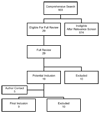The effect of a quantitative resuscitation strategy on mortality in patients with sepsis: a meta-analysis
- PMID: 18766093
- PMCID: PMC2737059
- DOI: 10.1097/CCM.0b013e318186f839
The effect of a quantitative resuscitation strategy on mortality in patients with sepsis: a meta-analysis
Abstract
Objective: Quantitative resuscitation consists of structured cardiovascular intervention targeting predefined hemodynamic end points. We sought to measure the treatment effect of quantitative resuscitation on mortality from sepsis.
Data sources: We conducted a systematic review of the Cochrane Library, MEDLINE, EMBASE, CINAHL, conference proceedings, clinical practice guidelines, and other sources using a comprehensive strategy.
Study selection: We identified randomized control trials comparing quantitative resuscitation with standard resuscitation in adult patients who were diagnosed with sepsis using standard criteria. The primary outcome variable was mortality.
Data abstraction: Three authors independently extracted data and assessed study quality using standardized instruments; consensus was reached by conference. Preplanned subgroup analysis required studies to be categorized based on early (at the time of diagnosis) vs. late resuscitation implementation. We used the chi-square test and I to assess for statistical heterogeneity (p < 0.10, I > 25%). The primary analysis was based on the random effects model to produce pooled odds ratios with 95% confidence intervals.
Results: The search yielded 29 potential publications; nine studies were included in the final analysis, providing a sample of 1001 patients. The combined results demonstrate a decrease in mortality (odds ratio 0.64, 95% confidence interval 0.43-0.96); however, there was statistically significant heterogeneity (p = 0.07, I = 45%). Among the early quantitative resuscitation studies (n = 6) there was minimal heterogeneity (p = 0.40, I = 2.4%) and a significant decrease in mortality (odds ratio 0.50, 95% confidence interval 0.37-0.69). The late quantitative resuscitation studies (n = 3) demonstrated no significant effect on mortality (odds ratio 1.16, 95% confidence interval 0.60-2.22).
Conclusion: This meta-analysis found that applying an early quantitative resuscitation strategy to patients with sepsis imparts a significant reduction in mortality.
Figures



Comment in
-
More evidence that timing matters in the treatment of patients with sepsis.Crit Care Med. 2008 Oct;36(10):2932-3. doi: 10.1097/CCM.0b013e31818700a2. Crit Care Med. 2008. PMID: 18812795 No abstract available.
-
Quantitative resuscitation in sepsis.CJEM. 2010 Mar;12(2):150-3. doi: 10.1017/s1481803500012185. CJEM. 2010. PMID: 20219163 No abstract available.
References
-
- Shoemaker WC, Appel PL, Kram HB, et al. Prospective trial of supranormal values of survivors as therapeutic goals in high-risk surgical patients. Chest. 1988;94:1176–1186. - PubMed
-
- Angus DC, Linde-Zwirble WT, Lidicker J, et al. Epidemiology of severe sepsis in the United States: Analysis of incidence, outcome, and associated costs of care. Crit Care Med. 2001;29:1303–1310. - PubMed
-
- Centers for Disease Control and Prevention. Current trends increase in national hospital discharge survey rates for septicemia—United States, 1979–1987. MMWR. 1991;39:31–34. - PubMed
-
- Rivers E, Nguyen B, Havstad S, et al. Early goal-directed therapy in the treatment of severe sepsis and septic shock. N Engl J Med. 2001;345:1368–1677. - PubMed
-
- Dellinger RP, Levy MM, Carlet JM, et al. Surviving sepsis campaign: International guidelines for management of severe sepsis and septic shock: 2008. Crit Care Med. 2008;36:296–327. - PubMed
Publication types
MeSH terms
Grants and funding
LinkOut - more resources
Full Text Sources
Other Literature Sources
Medical

